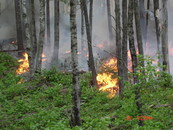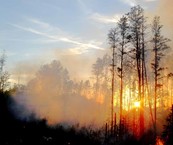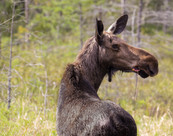|
Volume 8 - April 2022
Ecological Implications of Fire
Though it's hard to believe while many areas of the state are either muddy or still blanketed in snow, spring in Minnesota means the arrival of the prescribed fire season. This month's edition of the Reader highlights the importance of fire ecology in the state and how it relates to forest and wildlife management. We recognize this is a complex topic with many considerations ranging from costs and resources available to climate. This issue will focus on the ecological implications of fire management. And as the fire season draws near, there are several other resources available for you to consider:
- Last summer, the Greenwood fire in the Superior National Forest resulted in the loss of several residential properties and structures, widespread tree mortality, significant amounts of staff time and money, and the temporary closure of the Boundary Waters Canoe Area Wilderness. Listen to Lane Johnson, a research forester with the University of Minnesota Cloquet Forestry Center, and his take on how this season's snowfall can impact the risk of wildfires in 2022.
- The Chippewa National Forest, University of Minnesota and Leech Lake Band of Ojibwe are exploring the ecological effects of a human-augmented fire regime on Windigoominis (Star Island) in Cass Lake. The project is geared toward understanding historic cultural use of fire, its ecological effects and cultural benefits. Check out this storymap to learn more about this exciting partnership!
- We wanted to take the opportunity to highlight a related Forest Service Publication, Rooted in Research. Issues Two and Four are particularly relevant to this month's topic.
One other thing, fire season also means that it's almost field season for many researchers in Minnesota. If you'd like to conduct research on State Lands or Superior National Forest lands, here are the links with all the information you need to know:
State
Superior National Forest
The Minnesota Research Reader is a collaboration between the Minnesota Department of Natural Resources and the U.S. Department of Agriculture Forest Service that provides a quick look at emerging research relevant to our work in the State of Minnesota. We hope you enjoy the selection of articles in this month's edition of the Reader!

This article, published in 2021 by researchers with the University of Missouri and the USDA Forest Service Northern Research Station uses dendrochronological methods to date historical fire scarring events to reconstruct historical fire regimes in red pine dominated stands across the Mississippi River headwaters in northern Minnesota. Findings are then related to past climate, human land use changes and vegetation. Fire scar events are dated from 1565 – 1967 and show fire intervals ranging from one to 40 years, with a mean fire return interval of 6.6 years across the region. This study clearly demonstrates that fire played a significant role in shaping the region prior to European settlement. This study supports an emerging characterization of historical fire regimes of red pine forests in the Upper Lake States that include mixed severity fires, with a combination of infrequent, large-scale, high severity fires largely driven by climate, and more frequent, low severity surface fires, largely driven by human ignitions.
Management Implications:
- Within this region, stand replacing events were less common. Rather, fires likely created patchy openings of variable sizes leading to uneven-age stands with structural complexity. Smaller-scale, non-stand replacing disturbances may more accurately reflect historical disturbance patterns in silvicultural systems with high levels of structural retention.
- Fires in the study area predominantly occurred in the dormant season. This finding, along with the high frequency of low-intensity fires strongly suggests an important human element to ignition and burning in the region, specifically frequent burning by indigenous people during the shoulder seasons.
- Prescribed burning, along with silviculture practices such as irregular shelterwood methods may further support the restoration of natural structural complexity in red pine systems.
|

Released in 2016, this USDA Forest Service General Technical Report, authored by Northern Research Station research forester Melissa Thomas-Van Gundy and Forest Service regional ecologist Greg Nowacki, maps the influence of pre-European settlement fire on vegetation across Minnesota (see photo insert). Using bearing trees as indicators, this report delineates ecological land units based on the National Hierarchal Framework of Ecological Units to organize, interpret and describe pyrophilic percentage gradients across Minnesota within an ecological context. The maps and analyses presented provide a strong ecological basis for locating areas where long-term burning left an indelible mark on plant composition, structure and biodiversity, and thus where prescribed burning for ecosystem restoration is most appropriate today.
Management Implications:
- Fire was an important ecological process and evolutionary filter across the Minnesota landscape.
- Map products enable managers to identify locations where fire was common on the landscape before European settlement and thus where prescribed burning may be most appropriate today.
- Ecological units can be more accurately drawn by incorporating information on fire regimes as exhibited through pyrophilic percentage data.
|

Also published in 2016, this article was authored by a team of researchers from Minnesota, Wisconsin and Vermont. The study looks at how prescribed fire is increasingly being viewed as a valuable tool for mitigating the ecological consequences of long-term fire suppression within fire-adapted forest ecosystems. While the use of burning treatments in northern temperate conifer forests is increasingly considered by managers, the long-term effects on forest structure and development have not been quantified until now. This research quantifies the persistence of prescribed fire effects in a mature red pine dominated forest in northern Minnesota over a ∼50-year period. Researchers also investigate the relative roles of fire season and frequency in affecting individual tree and stand-level structural responses.
Management Implications:
- Prescribed fire may be a useful tool for meeting multiple forest management objectives in fire-dependent red pine stands – including fuel reduction, more open woodland ecosystems and park-like aesthetic, and larger diameter overstory trees – with minimal contribution to mortality in the overstory.
- Investment in multiple burns over a short period can have decades-long impacts on stand structure, long after fire treatments are ceased.
- Low intensity prescribed fire alone may not be sufficient to promote regeneration in fire-dependent forest systems; pairing fire with traditional silvicultural practices such as thinning and seed-tree or shelterwood harvest may be necessary to promote successful recruitment of new trees.
|

Though this study takes place in British Columbia, Canada, it has implications for moose habitat and fire management in Minnesota. The objective of this research was to investigate how different classes of fire severity interact with differing soil moisture regimes in determining how moose use post-fire habitat. Information is evaluated at both the site- and landscape-level. The findings have implications for how moose might use areas after wildfires and how to enhance moose habitat through prescribed burning. This study was published in 2021 by Kayla McNay and her associates in British Columbia.
Management Implications:
- At the site level, moose preferred areas of low/medium fire severity and hydric soil moisture.
- At the landscape level, habitat use and selection by moose varied by fire severity class with a decreasing trend in selection for low and medium fire severity at a finer resolution of selection (i.e., from home range to daily movements).
- Prescribed burning to enhance moose habitat should focus on low/medium fire severity at sites with mesic soil moisture.
|
|